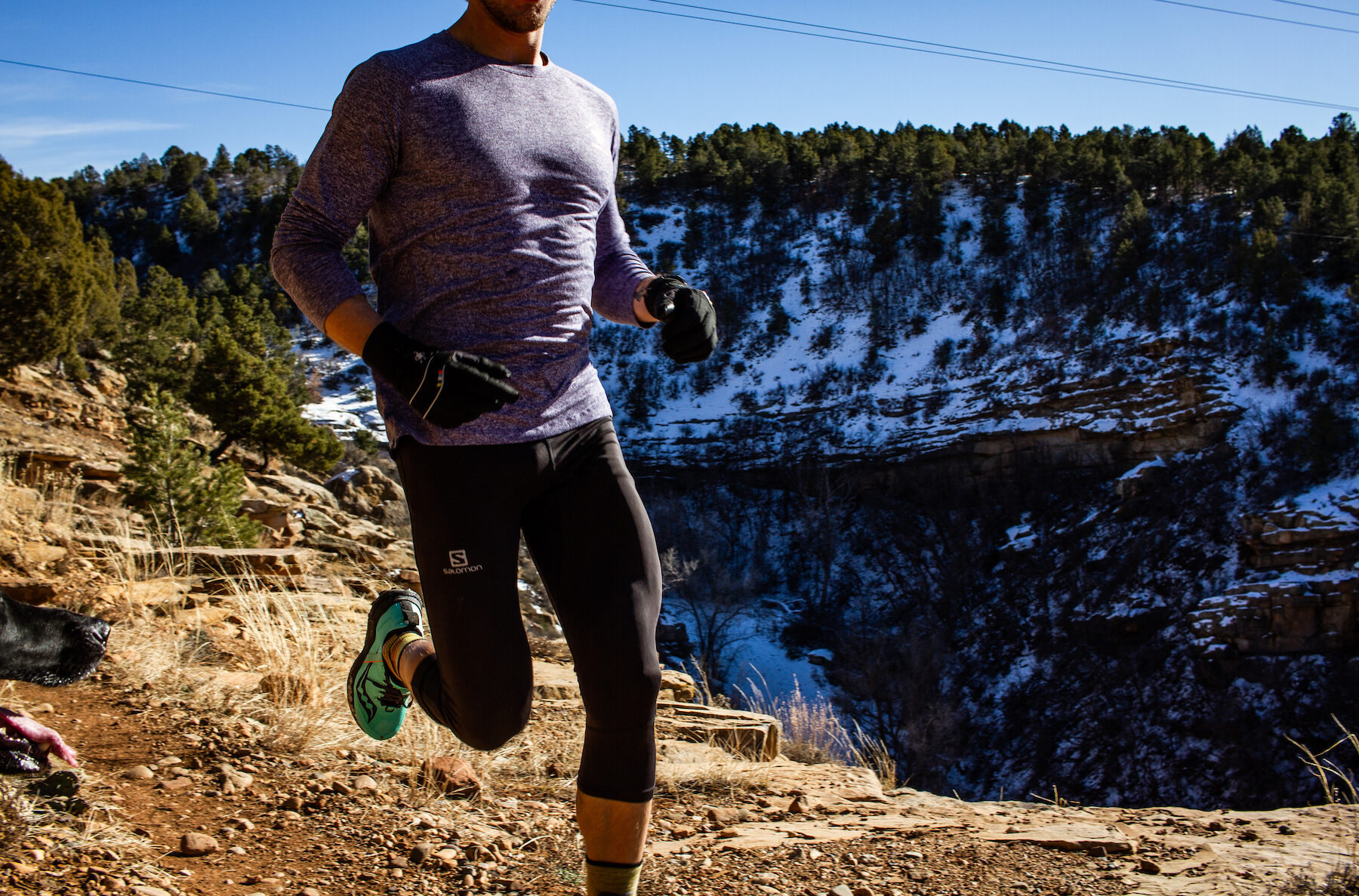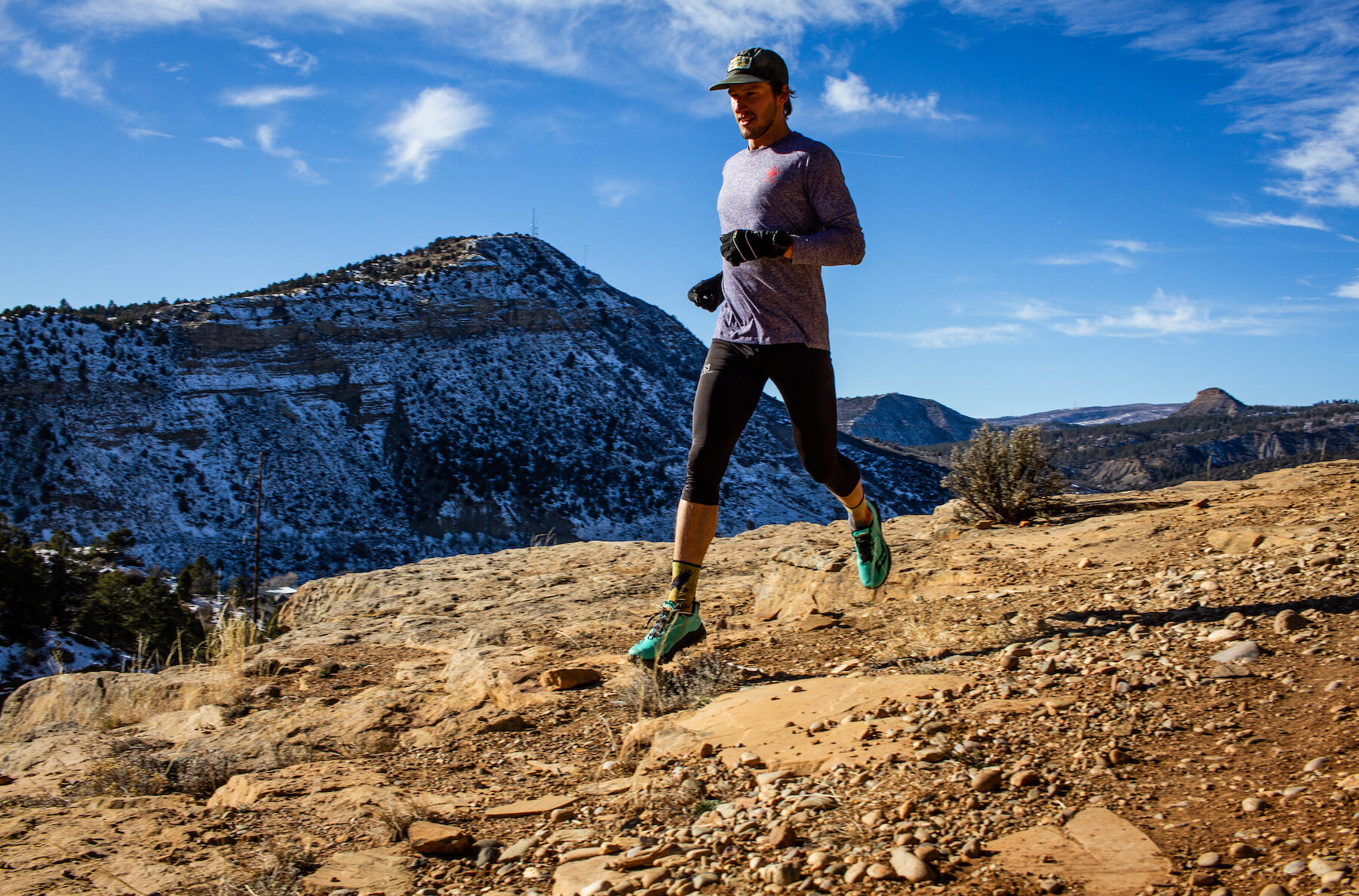Saucony Xodus Ultra
Test Location: Durango, Colorado
Test Duration: 73 miles (so far)
Stated Stack Height (Men’s): 32.5 mm (heel) / 26.5 mm (forefoot)
Stated Heel-to-toe Drop: 6 mm
Stated Features:
- A grippy 3-piece “PWRTRAC” outsole
- More minimal upper with fewer overlays to decrease hotspots
- “PWRRUN PB” midsole
- “Debris Shield” to keep out soil and sand
- A redesigned rock plate
- 4.5 mm lugs
- Gaiter compatible
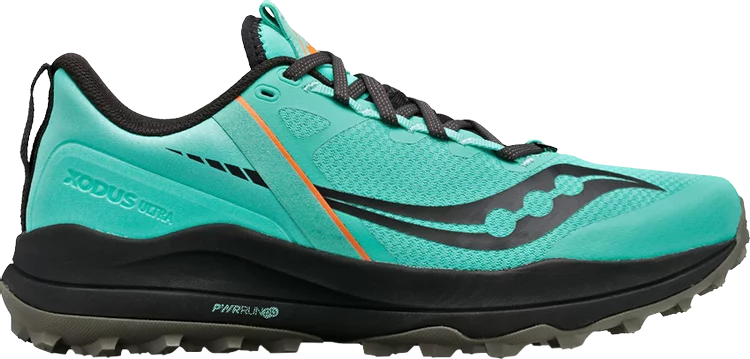
Stated Weight per Shoe (US Men’s Size 9): 292 g / 10.3 oz
MSRP: $150
Size Tested: US Men’s 9.5 / EU 43 1/3
Reviewer: 5’9”, 148lbs / 180 cm, 67 kg
Intro
Saucony has been making great strides (no pun intended) in the trail shoe department over the last few years, where they are continuing to solidify their place in an ever-expanding performance footwear market. The Xodus line has historically been home to the brand’s long-distance, beefy trail cruisers intended for long days on your feet and built to tackle a wide array of trail conditions. After running in the Xodus 10 a few seasons back, I felt like they were on the right track but needed significant improvement in one area specifically: weight. When I said beefy above, I am referring to a triple-stack bacon burger of a shoe. The Xodus 10 weighed in at 343 g / 12.1 oz for a US Men’s Size 9, and the Xodus 11 only improved on that slightly at 337 g / 11.9 oz for the same size.
However, Saucony recently gave their Xodus line a complete overhaul and managed to trim the new Xodus Ultra down to a very respectable 292 g / 10.3 oz in doing so. The shoe also benefits from a newly designed outsole, upper, and midsole that have so far proven to all be heading in the right direction performance-wise.
The Xodus Ultra took a few runs for me to dial it in before I felt like it was a real competitor in the ultra-distance, high-cushion trail shoe arena, but once I got Saucony’s “PWRRUN PB” midsole warmed up a bit, the shoe proved to be a worthy candidate. In this review, I’ll break down how the shoe’s reduction in weight serves as a skeleton key to unlocking its full potential and identify some areas that I think could stand to be updated and improved in a future version.
Fit
When I think of the best tongue design of any shoe I have worn, I immediately think of the La Sportiva Kaptiva. For my foot shape and preferences, that shoe’s fit approaches perfection. As soon as I felt the Xodus Ultra’s gusseted tongue and sockliner, the familiarity it shared with the Kaptiva sent my hopes skyrocketing; I knew I was in for a treat. The soft, stretchy, and neoprene-like tongue of the Xodus Ultra created a superb foot-hugging sensation that really held my foot in place nicely. As advertised, the toe box has been widened in this newest iteration, which, for my average-width foot shape, was on the ever-so-slightly wider side, making for some minor forefoot play on steep downhills. This is one of those shoes that just took a little extra dialing in to feel “just right” (more on that below).
As with the majority of brands, I went with a size US 9.5 / EU 43 ⅓ and found the length of the Xodus Ultra to be spot on. I had heard murmurs from others who had felt a hotspot on the lateral side of their pinky toes due to the overlays across the toe box on the upper, but I never ran into any issues with this myself. In fact, I found the upper design not only effective in decreasing weight, but was also made from really nice material that has both held up well so far and been relatively stretch-resistant. A lot of this success stems from the wider last the shoe is built on, a shape that’s much more forgiving than the narrower silhouettes seen on previous versions of the Xodus.
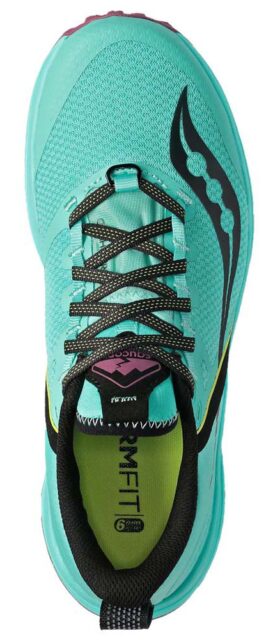
Hyper-long laces are a pet peeve of mine that I immediately notice on any shoe, the Xodus Ultra included. I really cannot stand longer than necessary laces, even despite the incorporation of lace loops on the top of the foot to slide the extra length into while running. However, this issue never came to undermine the fit of the Xodus Ultra like I expected, though it did have me quite worried during my first run. Within the first 2 miles, I started to feel the shoe’s ankle collar digging into the distal part of my ankle. I stopped, adjusted, re-tied the shoe, and continued on, only to feel this sensation come back in the next mile. I decided to cut that run short and head back home with the goal of figuring out the shoe’s fit a bit more on the next outing. On my next run, I really tried adjusting the Xodus Ultra’s gusseted tongue to lay a bit higher over my ankle, then tightened the laces with that placement in mind. Success. Once I made this fairly easy but conscious alteration, I never experienced that same discomfort again. On subsequent outings, I felt much more confident reaching for the Xodus Ultra knowing that the fit would now be dialed in.
A rather nitpicky but notable call out I’d like to make here has to do with the “FORMFIT” insole that Saucony integrates into the Xodus Ultra. This is an insole that did not work for me despite really giving it an honest try. So far, I have just over 70 miles in this shoe, and about at mile 50, I ended up switching the stock insoles out for a pair of Ortholite insoles from another shoe. The FORMFIT insole is composed of PU foam which is compressed and resembles compacted styrofoam beads (Adidas uses a similar material in their acclaimed “Boost” technology). While this material was undoubtedly comfortable, it was not confidence inspiring on technical terrain because it muted ground feel and really felt like it sapped some of the shoe’s energy return, in my experience. To echo my sentiment above, the Xodus Ultra required a bit more attention when it came to fitting my foot properly, but once settled, it had no issues ripping up and down the trails around Durango, CO.
Weight
As noted above, the Xodus was in need of some serious weight shedding. Fortunately for us, Saucony honed in on that goal and nailed it. Coming in at a stated 292 g / 10.3 oz in a US Men’s Size 9, we see a 45 g / 1.6 oz decrease in weight from the shoe’s previous iteration. The Xodus Ultra’s weight is fairly consistent with a lot of other trail shoe offerings in the ultra-distance category. For a shoe that places a ton of emphasis on ruggedness, the ability to handle big miles, comfort, and protection, sneaking in under 300 g is no easy feat. Below you can see some of the competitors in the ultra-distance trail shoe category and how they stack up to the Xodus Ultra as it relates to weight. All stated weights are based on a US Men’s Size 9.
270 g / 9.5 oz — Salomon Pulsar Trail Pro
284 g / 10.0 oz — Topo Athletic Mtn Racer 2
289 g / 10.2 oz — Hoka Speedgoat 5
292 g / 10.3 oz — Saucony Xodus Ultra
295 g / 10.4 oz — Hoka Mafate Speed 4
300 g / 10.5 oz — La Sportiva Jackal
303 g / 10.9 oz — Altra Timp 4
310 g / 10.9 oz — Dynafit Ultra 100
310 g / 10.9 oz — La Sportiva Akasha II
312 g / 11.0 oz — Brooks Caldera 6
It is worth mentioning here that the Xodus Ultra does have a slightly lower stack height than some of the shoes above, including the Hoka Speedgoat 5, Brooks Caldera 6, and a handful of others. While this definitely helps the Xodus Ultra maintain its slender (lighter) figure, it also allows it to feel more nimble than some of its peers. I would not go as far as to say that this shoe feels “light” underfoot by any means (compared to the whole trail shoe market), but I will say that it does not feel like a monster truck on your feet like previous editions of the Xodus did.
Upper
Jumping back into the positives, the upper material Saucony utilizes on the Xodus Ultra is simple, lightweight, and manages to be pretty stretch-resistant while also not feeling overly stiff in the toe box. While the version of the Xodus Ultra I tested is not the waterproof model ( Saucony does make one), I found that it performed really well on packed-out snow-covered trails. Despite the stripped-down nature of the Xodus Ultra’s upper, a decision intended to save weight, that area of the shoe has shown zero sign of wear so far. I really appreciate the simplistic use of protective overlays that the Xodus Ultra incorporates and found them to be located in all of the right areas without overdoing it. There is also a layer of material over the top of the eyelets Saucony calls their “Debris Shield,” which is designed to keep all dirt and debris from entering the shoe from any exposed portion of the laces. While this intention is a good one, it feels like maybe more of a gimmick feature than anything else to me, as that is not an area I typically find debris entering shoes very often.
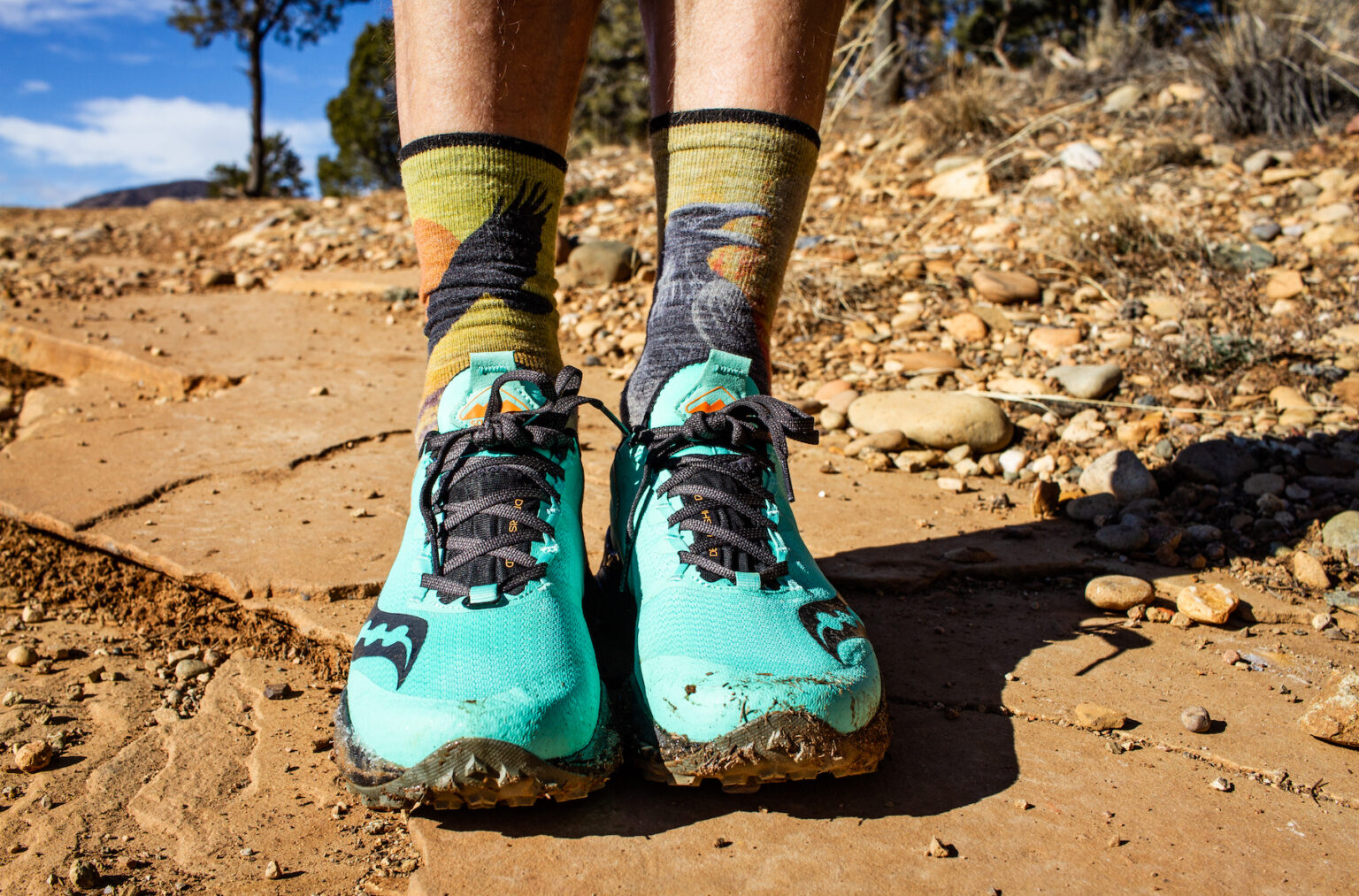
Midsole
Saucony’s “PWRRUN PB” midsole foam, which is what’s utilized in the Xodus Ultra, has been a fan favorite amongst the road running community for good reason. It’s a foam compound that strikes a great balance between stability, lasting energy return, and propulsion in a package that is relatively lightweight and does not break down quickly for most people. It’s also the same midsole compound found in the Saucony Endorphin Edge, a shoe that I found to be a blast on the trail and perhaps one of the most “road shoe feeling” trail shoes I have ever worn. With that in mind, I was quite disappointed by the Xodus Ultra’s midsole feel. What happened to that incredibly lively, fun-feeling midsole I had experienced before?
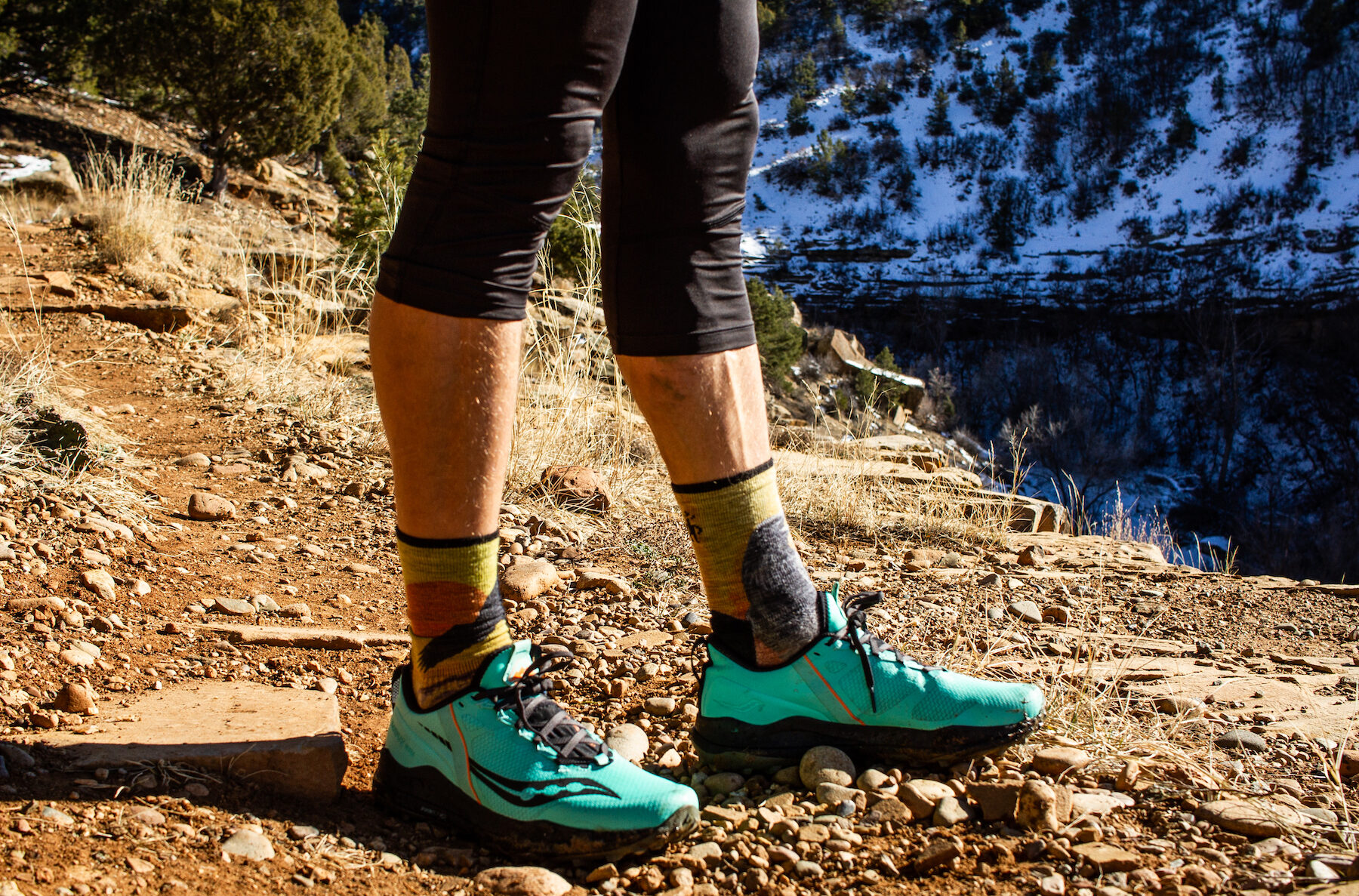
Now don’t get me wrong, I love a midsole that doesn’t feel dead after 100 miles and retains its’ performance over the long-haul. What I do not get down with is a midsole that feels dead from the start. The PWRRUN PB foam found in the Xodus Ultra is a denser, less-lively foam, a departure that I believe was done in part to be a bit more stable on technical terrain as well as stand the test of time — but I just never felt it come alive. Sure, I only have about 75 miles in the shoe so far, but even models with much firmer midsoles, such as the La Sportiva Akasha II, have proven to break in and feel better underfoot after 30 miles or so, in my experience. For a shoe that has its sights set on ultramarathons and high mileage training, I think that this is really where Saucony fell short with the Xodus Ultra. Not every shoe needs to be or should be exceptionally plush and high in rebound, but I do think that there could be significant improvements in the liveliness of this version of PWRRUN PB foam, when looking to future iterations of the Xodus Ultra.
Foam composition aside, I do think Saucony nailed the Xodus Ultra’s geometry (i.e., its stack height and heel-to-toe drop). With 32.5 mm of stack height in the heel and 26.5 mm in the forefoot, its midsole thickness is approachable. Not too maximal, not too minimal, the shoe felt nimble underfoot yet cushioned enough to handle longer distances. Couple the Xodus Ultra’s quite firm midsole with a reportedly “improved” rockplate and you have a shoe that will likely offer solid protection and stability on a wide variety of surface types. I just wish it had a bit more personality.
Outsole
The last trail shoe from Saucony that I ran in before the Xodus Ultra was the carbon-plated Endorphin Edge. This shoe came with a much different intended use than the Xodus Ultra. It was built for trail racing, a setting where Saucony could test the boundaries of what the integration of a carbon plate can do in a trail shoe. In those respects, the Endorphin Edge was a success and proved to be one of the quickest shoes I have ever worn (road or trail). However, what it did not do well was have an outsole that held up to rocks, technical trail, or really any condition other than buffed out, smooth singletrack. Within the first 20 miles of wearing that shoe, I experienced significant wear in the form of detached lugs. Scarred from that experience, I was not crazy optimistic about the longevity of Saucony’s proprietary outsole rubber compounds heading into this review. Fortunately, those fears were put to rest with the Xodus Ultra.
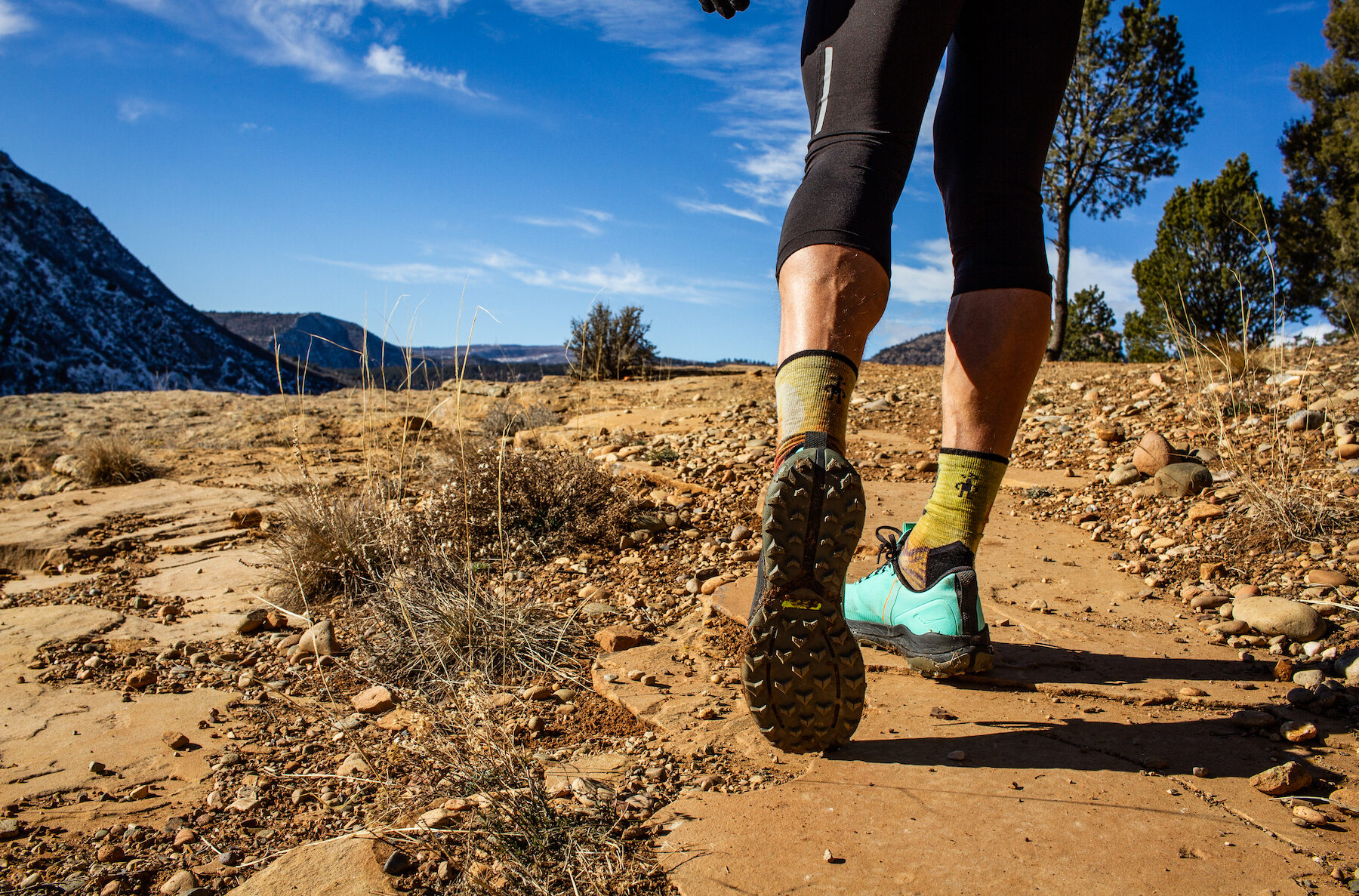
On Trail
When I began testing the Xodus Ultra there was about 1 inch of snow in my yard. By the end of my testing cycle, there were more than 40 (and counting). I was fortunate enough to get out in this shoe on some dry(ish) trails for about the first 45 miles of running. The last 30 were spent on primarily snow-packed trails around Durango, CO. This turned out to be a great test for the shoe’s PWRTRAC outsole, which received high praise after performing well on a wide variety of trails. It is worth reiterating here that this shoe does come in a waterproof version, which would be a great choice for this time of year in the Rocky Mountain West. The model I tested was not the waterproof edition, but nonetheless still performed great on snow-packed trails by virtue of its smartly designed outsole. I see this shoe being equally at home on smooth, buffed-out trails, as well as on technical surfaces like scree fields and in rock gardens. Versatility and reliability are things you need in a long-distance trainer and I believe that the Xodus Ultra reflects those qualities in its makeup. I’m looking forward to taking this shoe deep into the backcountry this spring and summer.
So, with ultra in the name, would I reach for this shoe for my long runs in the mountains or as my race-day go-to? In my opinion, this is not the shoe I would likely have in mind for race day or a long training day. I simply feel that there are other options in my personal quiver (and on the market) that check more of the boxes in what I am looking for in an ultra-distance trail model, whether that’s fitting my foot better or having a more reactive midsole. I do really want to emphasize that Saucony made huge improvements in this iteration of the Xodus and I am excited to see what a little bit of refinement can do for the next version. If we could get more of that PWRRUN PB midsole feel celebrated in Suacony’s Endorphin series injected into the Xodus, I think we’d have a real gem of a trail shoe.
Durability
The outsole on the Xodus Ultra is going to really help boost this shoe’s durability rating, in my opinion. This, along with the firm blend of PWRRUN PB, makes for a shoe that I predict will last between 400-500 miles for most folks. Of course, this is dependent on many factors, but I foresee this being a shoe that will outlast some of the ultra-distance-focused shoes in its category, especially those softer midsoles that may take a shorter amount of time to decompress. From my testing so far, I saw no weak spots in the upper or fraying of any kind elsewhere on the shoe. Saucony really seems to have prioritized durability when designing the Xodus Ultra. I was especially pleased with how well the shoe’s outsole has held up compared to my experience in the Endorphin Edge, which began to show significant wear in that area within the first 30 miles of use. I can see this shoe being a great daily trainer for someone who wants a reliable shoe no matter the terrain and is looking for an option that will likely last them an entire training block, or several.
Who’s It For?
The Saucony Xodus Ultra is a shoe that I feel could be used for a wide array of training purposes and scenarios. I continually came back to the thought of this being a great entry-level trail running shoe; it has a generous stack height and trends toward wanting to run slower-paced miles. I could see this shoe being a great daily trainer for runners not trying to nail any PRs but who would rather just cruise the local trails after work, all while still being able to take them out for bigger objectives on the weekend. I tested this shoe over a wide range of trail conditions here in Durango, CO — from early winter’s slushy trails to rocky technical slick rock — and found it to really thrive in shoulder seasons. So, if you are in the habit of year-round running and live somewhere where the trails tend to get pretty soupy in the fall / spring, consider checking out the Xodus Ultra. Saucony has really found something in their PWRTRAC outsole and the shoe benefits from it immensely.
Bottom Line
Simply put, the Xodus Ultra is a marked improvement on previous iterations of Saucony’s Xodus line. The shoe drops some much-needed weight without undermining its intended use as a maximal option for bouncing along a wide variety of trial types and conditions, including wet and slippery surfaces. That said, it’s not without its flaws. While the Xodus Ultra implements the brand’s coveted PWRRUN PB foam in its redesigned midsole, we felt like it sometimes lacked the vibrancy and rebound experienced in shoes that incorporate the same material. But despite perhaps missing the energy return needed for top-tier performance, the Xodus Ultra still shapes up as a great option for beginner trail runners feeling out the trails for the first time, or for folks who’re after a capable everyday trainer that can still take care of business on weekend adventures.

